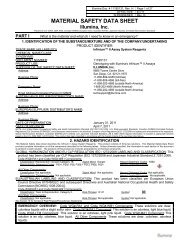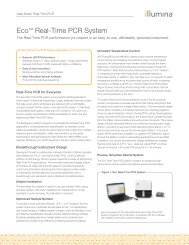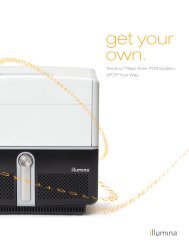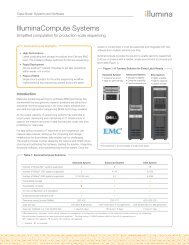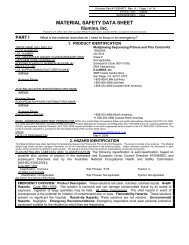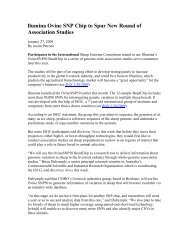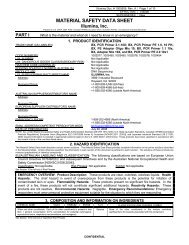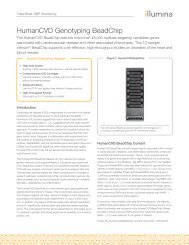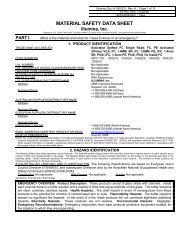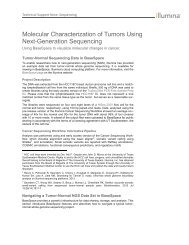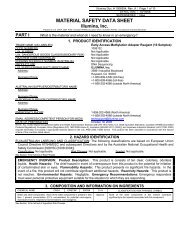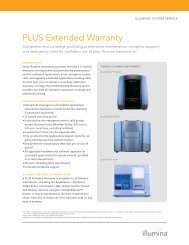MATERIAL SAFETY DATA SHEET - Illumina
MATERIAL SAFETY DATA SHEET - Illumina
MATERIAL SAFETY DATA SHEET - Illumina
Create successful ePaper yourself
Turn your PDF publications into a flip-book with our unique Google optimized e-Paper software.
TruSeq Enrichment Kit <strong>Illumina</strong> Doc. #15018476, Rev. A Page 17 of 17<br />
NATIONAL FIRE PROTECTION ASSOCIATION HAZARD RATINGS<br />
(continued):<br />
INSTABILITY HAZARD: 0 Materials that in themselves are normally stable, even under<br />
fire conditions. Materials that have an instantaneous power density (product of heat of<br />
reaction and reaction rate) at 250°C (482°F) below 0.01 W/mL. Materials that do not<br />
exhibit an exotherm at temperatures less than or equal to 500°C (932°F) when tested<br />
by differential scanning calorimetry. 1 Materials that in themselves are normally stable,<br />
but that can become unstable at elevated temperatures and pressures. Materials that<br />
have an instantaneous power density (product of heat of reaction and reaction rate) at<br />
250°C (482°F) at or above 0.01 W/mL and below 10 W/mL. 2 Materials that readily<br />
undergo violent chemical change at elevated temperatures and pressures. Materials<br />
that have an instantaneous power density (product of heat of reaction and reaction<br />
rate) at 250°C (482°F) at or above 10 W/mL and below 100W/mL. 3 Materials that in<br />
themselves are capable of detonation or explosive decomposition or explosive<br />
reaction, but that require a strong initiating source or that must be heated under<br />
confinement before initiation. Materials that have an estimated instantaneous power<br />
density (product of heat of reaction and reaction rate) at 250°C (482°F) at or above 100<br />
W/mL and below 1000 W/mL. Materials that are sensitive to thermal or mechanical<br />
shock at elevated temperatures and pressures. 4 Materials that in themselves are<br />
readily capable of detonation or explosive decomposition or explosive reaction at<br />
normal temperatures and pressures. Materials that are sensitive to localized thermal or<br />
mechanical shock at normal temperatures and pressures. Materials that have an<br />
estimated instantaneous power density (product of heat of reaction and reaction rate)<br />
at 250°C (482°F) of 1000 W/mL or greater.<br />
FLAMMABILITY LIMITS IN AIR:<br />
Much of the information related to fire and explosion is derived from the National Fire<br />
Protection Association (NFPA). Flash Point: Minimum temperature at which a liquid<br />
gives off sufficient vapor to form an ignitable mixture with air near the surface of the<br />
liquid or within the test vessel used. Autoignition Temperature: Minimum temperature of<br />
a solid, liquid, or gas required to initiate or cause self-sustained combustion in air with<br />
no other source of ignition. LEL: Lowest concentration of a flammable vapor or gas/air<br />
mixture that will ignite and burn with a flame. UEL: Highest concentration of a<br />
flammable vapor or gas/air mixture that will ignite and burn with a flame.<br />
DEFINITIONS OF TERMS (Continued)<br />
TOXICOLOGICAL INFORMATION:<br />
Human and Animal Toxicology: Possible health hazards as derived from human data,<br />
animal studies, or from the results of studies with similar compounds are presented.<br />
LD50: Lethal Dose (solids & liquids) that kills 50% of the exposed animals. LC50: Lethal<br />
Concentration (gases) that kills 50% of the exposed animals. ppm: Concentration<br />
expressed in parts of material per million parts of air or water. mg/m 3 : Concentration<br />
expressed in weight of substance per volume of air. mg/kg: Quantity of material, by<br />
weight, administered to a test subject, based on their body weight in kg. TDLo: Lowest<br />
dose to cause a symptom. TCLo: Lowest concentration to cause a symptom. TDo,<br />
LDLo, and LDo, or TC, TCo, LCLo, and LCo: Lowest dose (or concentration) to cause<br />
lethal or toxic effects. Cancer Information: IARC: International Agency for Research<br />
on Cancer. NTP: National Toxicology Program. RTECS: Registry of Toxic Effects of<br />
Chemical Substances. IARC and NTP rate chemicals on a scale of decreasing potential<br />
to cause human cancer with rankings from 1 to 4. Subrankings (2A, 2B, etc.) are also<br />
used. Other Information: BEI: ACGIH Biological Exposure Indices, represent the levels<br />
of determinants which are most likely to be observed in specimens collected from a<br />
healthy worker who has been exposed to chemicals to the same extent as a worker<br />
with inhalation exposure to the TLV.<br />
ECOLOGICAL INFORMATION:<br />
EC: Effect concentration in water. BCF: Bioconcentration Factor, which is used to<br />
determine if a substance will concentrate in life forms that consume contaminated plant<br />
or animal matter. TLm: Median threshold limit. log KOW or log KOC: Coefficient of<br />
Oil/Water Distribution is used to assess a substance’s behavior in the environment.<br />
REGULATORY INFORMATION:<br />
U.S. and CANADA:<br />
This section explains the impact of various laws and regulations on the material. EPA:<br />
U.S. Environmental Protection Agency. ACGIH: American Conference of Governmental<br />
Industrial Hygienists, a professional association that establishes exposure limits. OSHA:<br />
U.S. Occupational Safety and Health Administration. NIOSH: National Institute of<br />
Occupational Safety and Health, which is the research arm of OSHA. WHMIS:<br />
Canadian Workplace Hazardous Materials Information System. DOT: U.S. Department<br />
of Transportation. TC: Transport Canada. SARA: Superfund Amendments and<br />
Reauthorization Act. DSL/NDSL: Canadian Domestic/Non-Domestic Substances List.<br />
TSCA: U.S. Toxic Substance Control Act. CERCLA: Comprehensive Environmental<br />
Response, Compensation, and Liability Act. Marine Pollutant status according to the<br />
DOT; CERCLA or Superfund; and various state regulations. This section also includes<br />
information on the precautionary warnings that appear on the material’s package label.<br />
EUROPE:<br />
EU: European Union (formerly known as the EEC, European Economic Community).<br />
EINECS: European Inventory of Now-Existing Chemical Substances. ARD: European<br />
Agreement Concerning the International Carriage of Dangerous Goods by Road. RID:<br />
International Regulations Concerning the Carriage of Dangerous Goods by Rail.<br />
AUSTRALIA:<br />
AICS: Australian Inventory of Chemical Substances. NOHSC: National Occupational<br />
Health & Safety Code.<br />
JAPAN:<br />
METI: Ministry of Economy, Trade and Industry.



